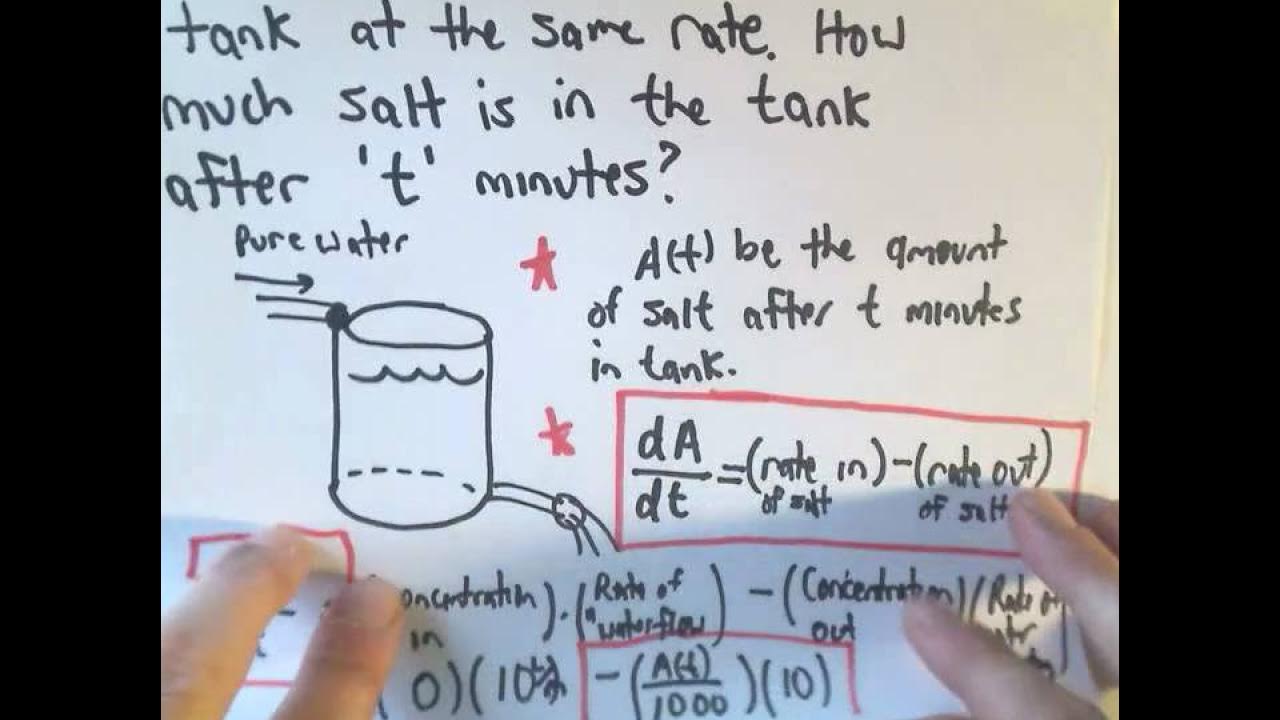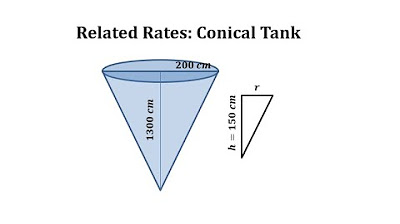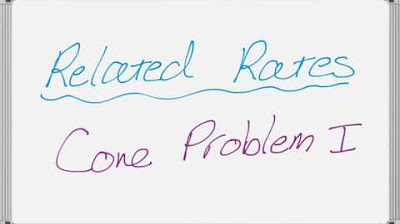calculus 2 mixing problem, CSTR, differential equation application
TLDRThe video script presents a classic mixed problem involving a differential equation related to a tank containing a solution of water and alcohol. Initially, the tank holds 60 gallons with 85% water and 15% alcohol. A second solution, which is half water and half alcohol, is added to the tank at a rate of 4 gallons per minute, while the tank is simultaneously drained at the same rate. The challenge is to determine the amount of alcohol in the tank after 10 minutes, assuming the solution is well-stirred. The problem is formulated into a differential equation where the rate of alcohol inflow (2 gallons per minute, considering the concentration) is balanced against the outflow, which is calculated based on the changing alcohol concentration in the tank. The differential equation is solved using separation of variables and integration techniques, with the initial condition that there are 9 gallons of alcohol at time zero. The final calculation reveals that after 10 minutes, there will be approximately 19.22 gallons of alcohol in the tank.
Takeaways
- 🚰 The initial tank contains 60 gallons of a solution with 85% water and 15% alcohol.
- 🔄 A second solution, half water and half alcohol, is added to the tank at a rate of 4 gallons per minute.
- 🚮 The tank is simultaneously drained at the same rate of 4 gallons per minute, maintaining the tank's volume at 60 gallons.
- 🧮 To find the amount of alcohol in the tank after 10 minutes, a differential equation is set up based on the rate of alcohol entering and leaving the tank.
- 📈 The rate of alcohol entering the tank is calculated as 2 gallons per minute (half of the 4 gallons per minute input rate).
- 📉 The rate of alcohol leaving the tank is determined by the current concentration of alcohol in the tank, which changes over time.
- 🌀 The solution in the tank is well-stirred, ensuring a uniform concentration at any given time.
- ✍️ The differential equation is formulated as \( \frac{dA}{dt} = 4 \times 0.5 - 4 \times \frac{A}{60} \), where \( A \) is the amount of alcohol in the tank.
- 🔢 The initial condition is \( A(0) = 60 \times 0.15 = 9 \) gallons of alcohol at time \( t = 0 \).
- 🧵 The solution to the differential equation is separated and integrated to find the function \( A(t) \), representing the amount of alcohol over time.
- 🔍 By applying the initial condition, the constant in the integrated equation is solved, providing the complete function for \( A(t) \).
- ⏱ After 10 minutes (\( t = 10 \) minutes), the tank contains approximately 19.22 gallons of alcohol, as calculated using the derived function.
Q & A
What is the initial setup of the tank in terms of solution composition?
-The tank initially contains 60 gallons of solution with 85% water and 15% alcohol, totaling to 51 gallons of water and 9 gallons of alcohol.
What type of solution is being added to the tank, and what is its composition?
-The solution being added is a mixture of half water and half alcohol, which is being added at a rate of 4 gallons per minute.
How does the inflow and outflow of the solution affect the tank's total volume?
-Both the inflow and outflow occur at the rate of 4 gallons per minute, maintaining the total volume of the tank at a constant 60 gallons.
What is the rate of alcohol coming into the tank?
-Since the incoming solution is half alcohol and it flows at 4 gallons per minute, the rate of alcohol entering the tank is 2 gallons per minute.
How is the rate of alcohol going out of the tank calculated?
-The rate of alcohol going out is determined by the current concentration of alcohol in the tank, multiplied by the outflow rate, which is 4 gallons per minute.
What changes occur to the concentration of alcohol in the tank over time?
-The concentration of alcohol in the tank increases over time as the incoming solution has a higher alcohol percentage (50%) compared to the initial alcohol concentration (25%).
How do you calculate the concentration of a substance in a solution?
-The concentration of a substance in a solution is calculated by dividing the amount of the substance by the total volume of the solution.
What is the differential equation used to model the situation?
-The differential equation used is dA/dt = 2 - (A/15), where A is the amount of alcohol in the tank at any given time.
What is the significance of the initial condition in solving the differential equation?
-The initial condition, A(0) = 9, represents the initial amount of alcohol in the tank. It is crucial for solving the differential equation as it allows the calculation of specific constants in the equation.
What is the amount of alcohol in the tank after 10 minutes?
-After 10 minutes, the amount of alcohol in the tank is approximately 19.22 gallons.
Outlines
🤔 Introduction to the Mixed Differential Equation Problem
The video begins by introducing a classic mixed equation in the form of a differential equation. The problem involves a tank initially containing 60 gallons of a solution with 85% water and 15% alcohol. A second solution, which is half water and half alcohol, is added to the tank at a rate of 4 gallons per minute. Simultaneously, the tank is drained at the same rate, maintaining a constant volume. The goal is to determine the amount of alcohol in the tank after 10 minutes, assuming the solution is well stirred. An analogy of household income and expenditure is used to explain the concept of the rate of change.
📚 Setting Up the Differential Equation
The video continues by setting up the differential equation to model the situation. It explains that the rate of alcohol coming into the tank is 2 gallons per minute, which is half of the 4 gallons per minute input rate due to the concentration of alcohol in the second solution. The flow out rate is also 4 gallons per minute, but the concentration of alcohol going out changes over time. The concentration is calculated as the amount of alcohol divided by the total volume, which remains constant at 60 gallons. The differential equation is formulated as dA/dt = (4 * 0.5) - (4 * A/60), where A is the amount of alcohol in the tank. An initial condition is given as A(0) = 9 gallons, representing the alcohol present at the start.
🔍 Solving the Differential Equation
The presenter then demonstrates how to solve the differential equation. By multiplying through by 15 to eliminate fractions, the equation is simplified and separated. Integration yields an equation involving the natural logarithm. The constants are isolated, and the equation is solved for A(t), the amount of alcohol at time t. The integration process involves moving terms around and combining like terms, resulting in an equation with an exponential function. The constants are further simplified to arrive at a final form for A(t).
🎯 Applying the Initial Condition and Finding the Final Amount
With the differential equation solved, the video applies the initial condition to find the constant of integration. It is determined that c5 = -21, which is then used to find the final form of the equation for A(t). The equation is A(t) = 30 - 21 * e^(-1/15 * t). To find the amount of alcohol in the tank after 10 minutes, A(10) is calculated. Using a calculator, the presenter finds that A(10) is approximately 19.22 gallons, rounding to the nearest hundredth. This concludes the solution to the problem, showing that after 10 minutes, there will be about 19.22 gallons of alcohol in the tank.
Mindmap
Keywords
💡Differential Equation
💡Initial Condition
💡Flow Rate
💡Concentration
💡Separation of Variables
💡Integration
💡Exponential Function
💡Stirred Tank
💡Alcohol Content
💡Tank Volume
💡Rate of Change
Highlights
The problem involves a tank initially containing 60 gallons of a solution with 85% water and 15% alcohol.
A second solution, half water and half alcohol, is added to the tank at a rate of 4 gallons per minute.
The tank is simultaneously drained at the same rate of 4 gallons per minute, maintaining a constant volume of 60 gallons.
The goal is to determine the amount of alcohol in the tank after 10 minutes with the solution being well-stirred.
An analogy of household income and expenditure is used to explain the concept of rate of change.
The rate of alcohol entering the tank is calculated by multiplying the flow rate by the concentration of alcohol in the incoming solution.
The differential equation is set up by considering the rate of alcohol inflow and outflow, taking into account the concentration changes.
The initial condition is given as 9 gallons of alcohol at time zero, calculated from the initial concentration and volume.
The differential equation is solved by separating variables and integrating both sides.
To avoid working with fractions, the equation is multiplied by 15 to simplify the calculation.
The solution to the differential equation involves natural logarithms and exponential functions.
Constants are identified and isolated during the integration process to simplify the equation further.
The initial condition is used to solve for the constant of integration, which is found to be -21.
The final equation for the amount of alcohol in the tank over time is derived and simplified.
The equation is evaluated at 10 minutes (a(t) at t=10) to find the amount of alcohol in the tank at that time.
The calculated amount of alcohol in the tank after 10 minutes is approximately 19.22 gallons.
The solution process emphasizes the importance of setting up the differential equation and understanding the underlying concepts.
Transcripts
Browse More Related Video

Mixing Problems and Separable Differential Equations

Related Rates Applicate: Leaking Conical Tank

Worked example: problem involving definite integral (graphical) | AP Calculus AB | Khan Academy

Related Rates - Filling a Cone Problem

Calculus gr 12 Exam Questions

Related Rates - Gravel Dumped Into Conical Tank Problem
5.0 / 5 (0 votes)
Thanks for rating: